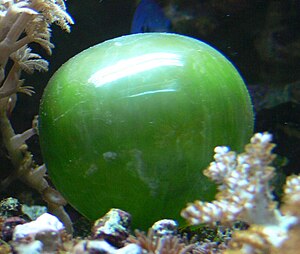Bladder algae
| Bladder algae | ||||||||||||
|---|---|---|---|---|---|---|---|---|---|---|---|---|

Bladder algae ( Valonia ventricosa ) |
||||||||||||
| Systematics | ||||||||||||
|
||||||||||||
| Scientific name | ||||||||||||
| Valonia ventricosa | ||||||||||||
| J. Agardh |
The bladder alga ( Valonia ventricosa ) is a unicellular green alga that occurs worldwide in tropical and subtropical seas. With a diameter of up to five centimeters, it is one of the largest single-celled living things. Since it is immunologically more similar to the species of the genera Dictyosphaeria and Siphonocladus , has a noticeably reduced morphology and, in contrast to other Valonia species, reproduces through segregative cell division , some authors have included it in their own genus Ventricaria J.L. Olsen & JA West posed.
features
The thallus of the bladder alga consists of a single, thin-walled, multinucleated cell with a diameter of one to four centimeters, and rarely more. The shape is, depending on the environment, spherical to oval, often with a narrowed base. The color varies from grass green to dark green and is due to numerous disc-shaped chloroplasts . The surface has a glass-like shine. The bladder algae cell is attached to the substrate by hair-thin rhizoids .
Occurrence and way of life
Bladder algae usually grow individually, rarely also in smaller groups in the tidal range of tropical and subtropical seas, often on coral debris . The greatest depths reached by the species are around 80 meters. The multiplication takes place through segregative cell division, whereby the multinucleated cell decays into several daughter cells. In addition, individual rhizoids can form new bubbles, which then separate from the mother organism. The sexual reproduction of the species has not yet been studied in detail.
proof
- Wolfram Braune: marine algae . ARG Gantner, Ruggell 2008, ISBN 978-3-906166-69-8 , pp. 60 .
- Ventricaria at algaebase.org